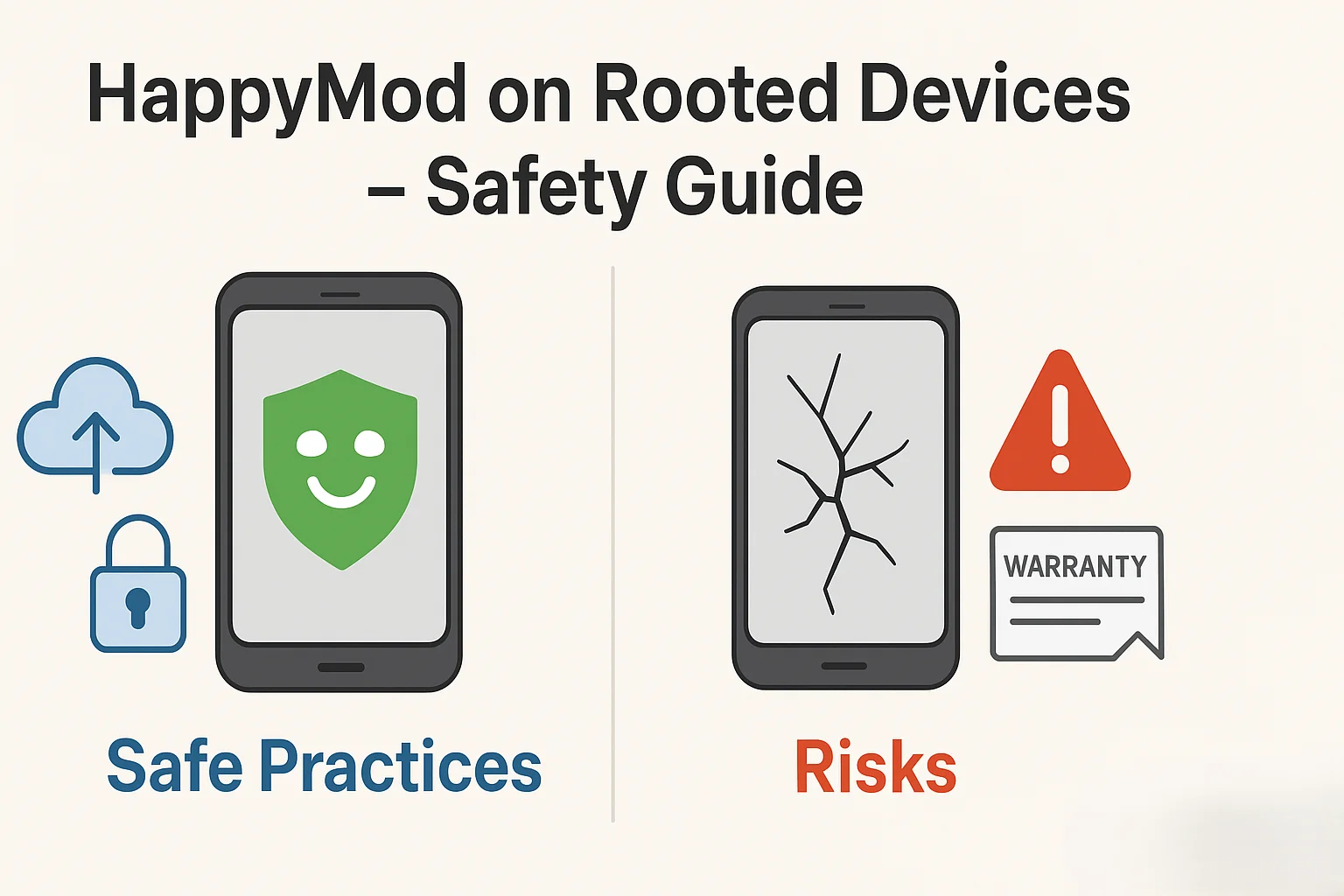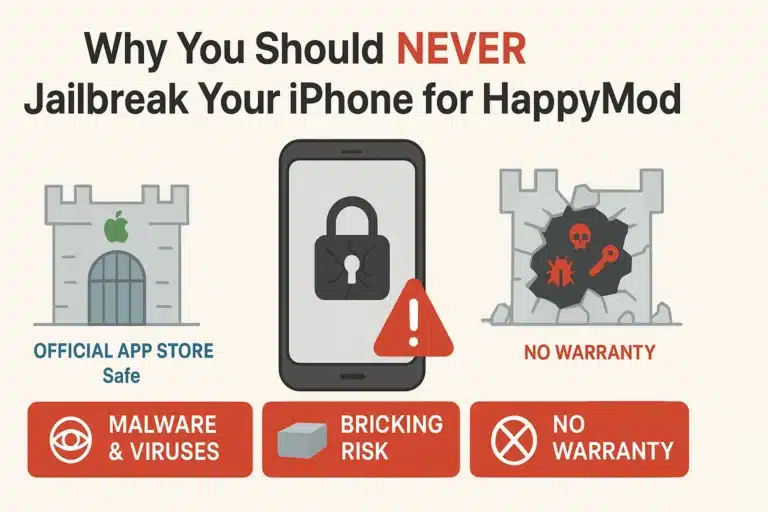A Complete Safety Guide to Using HappyMod on a Rooted Device
You are asking an advanced question, and you deserve a clear, honest answer. Using modded applications on a rooted Android device can give you access to powerful features. However, it also comes with very serious risks if you do not do it correctly.
We want to be completely open with you: our main job is to keep you secure. This guide will not just show you the steps to install HappyMod on a rooted device. More importantly, it will explain the potential dangers and the exact safety steps you must take to protect yourself. This is an important part of our complete HappyMod Safety Guide.
Critical First: Do You Actually Need to Root Your Phone?
Before we go any further, we need to make one thing perfectly clear. You DO NOT need to root your phone to use Happy Mod.
The official HappyMod application and almost all of the mods it offers are made to work perfectly on standard, unrooted Android devices. The creators of these mods know that most people do not have rooted phones, so they design their apps to work without special permissions. Rooting is an extreme step that is not needed for 99% of users who just want to enjoy modded apps.
What is Rooting?
To understand the risks, you first need to understand what rooting is. Think of your phone’s operating system like a large office building. As a normal user, you have a keycard that lets you into the main floors and your own office. This is safe and gives you access to everything you need.
However, the building’s main control room is kept locked. This room contains the master switches for the electricity, the security system, and the building’s foundation. This is the “root” level of your phone’s system files. It is locked to prevent anyone from accidentally causing a building-wide blackout or breaking something important.
“Rooting” is the process of gaining access to a control room. It gives you “root access,” which makes you the administrator of the entire system. You can now change anything you want. This allows for deep customizations, but it also removes all the safety locks and warning signs that were designed to protect your device from critical errors and security threats.
The Real Risks of Using Mods on a Rooted Device
If you decide to root your phone, you are accepting full responsibility for what happens next. You must understand the following dangers before you proceed.
Increased Security Vulnerabilities
The Problem: The safety features that rooting removes are there for a reason. They are designed to keep apps in their own separate sandboxes so they cannot access your private information. On a rooted device, these walls are gone. A malicious app that gets root access could take complete control of your phone. It could read your passwords, access your banking apps, view your private photos, or install hidden malware that is almost impossible to remove.
The Precaution: You must be extremely careful about what you install. Only install mods from sources that have a very high number of positive and recent community reviews. Never grant root access to an app you do not trust 100%.
Risk of “Bricking” Your Device
The Problem: A “bricked” phone is one that will not turn on or function at all. It is basically an expensive brick. This can happen if a poorly coded mod or a wrong system change corrupts your phone’s most important software. In the office building analogy, this is like flipping the wrong master switch and permanently short-circuiting the entire building’s power grid. Sometimes, this damage cannot be undone.
The Precaution: Before you make any system-level changes on a rooted device, you must always create a full backup of your system. This is called a “Nandroid backup,” and it saves a perfect copy of your entire phone’s software.
Voiding Your Warranty
The Problem: The company that made your phone provides a warranty that covers repairs for hardware problems. In almost every case, rooting your device will instantly void that warranty. The manufacturers put those software locks in place for system stability. If you remove them and something breaks, they will likely refuse to fix your device, even if the problem seems unrelated.
The Precaution: You should only root your device if you are comfortable with this risk. You must accept that you are now fully responsible for any and all repairs.
What to Do BEFORE Installing on a Rooted Device
If you have read all the risks and still wish to use HappyMod on a rooted device, you must follow this safety checklist. Do not skip any of these steps.
Understand the risks with our Android App Permissions Explained guide.
How to Install HappyMod on an Already Rooted Device
If you have a rooted device and have completed the entire safety checklist, the installation process itself is quite simple.
Using HappyMod on a rooted device is a task for advanced users who fully understand and accept the risks involved. While it can offer a deeper level of customization, your security must always be your first priority.
For the vast majority of users, the safest and best way to enjoy everything HappyMod has to offer is on a standard, unrooted device.
Return to our homepage to get the latest, analyst tested HappyMod.
People Also Ask: TheHappyMod FAQ
Do I need to root my phone to use HappyMod?
No, absolutely not. This is the most common misunderstanding. The HappyMod app store and over 99% of the mods available through it are designed to work perfectly on normal, unrooted Android devices. Rooting is an extreme and unnecessary step for almost everyone.
How can I check if a mod is safe for a rooted phone?
The standard for a rooted phone must be much higher. When you are inside the HappyMod app, you need to check the mod’s page very carefully:
Look for a very high “working percentage” (we recommend 85% or higher).
Read the recent comments very carefully. Pay special attention to what other users with rooted devices have said about their experience. Their feedback is your best guide.
Are there any actual benefits to using HappyMod on a rooted device?
For a very small number of highly technical users, yes. Some extremely complex mods that need to change deep system files might require root access. These can offer a level of customization that is not possible on a standard device. However, for the average user, these small benefits do not outweigh the significant security dangers.

Jonathan Jude – Tech Blogger & Security Analyst
Based in Los Angeles, Jonathan Jude is a tech blogger with three years of experience testing mobile software. He writes direct, analysis based guides for Android applications.
His work focuses on a transparent testing process that checks each app for security and function. This gives users a clear report on software safety and performance. Connect with Jonathan Jude on LinkedIn and Facebook.







